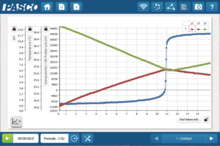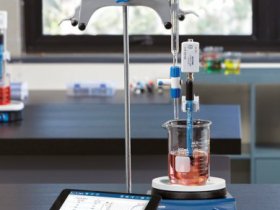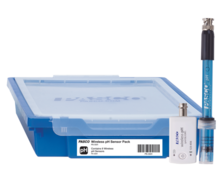Use the new Wireless Drop Counter for more efficient and accurate titration data. Conducting a titration has never been easier!
- 1x Wireless Drop Counter
- 1x Micro Stir Bar
- 1x Drop Dispenser with Stopcock
- 1x Plastic Dispenser Rod Clamp
See the Buying Guide for this item's required, recommended, and additional accessories.
Product Summary
The Wireless Drop Counter has a wider (18 x 13 mm) drop window for better drop detection and easier alignment with burettes. It works equally well with large or small, fast or slow drops.
Able to measure up to 40 events per second with drops as small as 0.5 mm.
Teaching Advantage
- IR filter assures accurate counts because room lighting cannot affect results
- Sensor unit can suspend two other probes in solution, simplifying many experiments
- Wider drop window (18 x 13 mm) means better drop detection and easier alignment with burettes
What's Included
- 1x Wireless Drop Counter
- 1x Micro Stir Bar
- 1x Drop Dispenser with Stopcock
- 1x Plastic Dispenser Rod Clamp
Product Specifications
| Drop Resolution | 1 drop |
| Maximum Drop Count Rate | 40 drops/second |
| Exterior Case | ABS Plastic |
| Optical Window | Acrylic |
| Connectivity | USB and Bluetooth 5.2 |
| Logging | No |
| Battery Type | Rechargeable LiPo |
Battery & Logging
| Stored Data Points Memory (Logging) 1 | Not Supported |
| Battery - Connected (Data Collection Mode) 2 | >260 hr |
| Battery - Logging (Data Logging Mode) 3 | Not Supported |
| Battery Type | Rechargeable LiPo |
1 Minimum # of data points with all measurements enabled, actual results depend on enabled measurements.
2 Continuous use in a connected state until battery failure, actual results will depend on sample rate, active measurements, and battery condition.
3 Logging until battery failure, actual results will depend on sample rate, active measurements, and battery condition.
* Normal classroom use is the sensor in active use for 20min/lab for 120 lab periods/yr.
Data Collection Software
This product requires PASCO software for data collection and analysis. We recommend the following option(s). For more information on which is right for your classroom, see our Software Comparison: SPARKvue vs. Capstone »
Connectivity Options
This product can connect directly to your computer or device with the following technologies. No Interface required. See the following guide for details regarding device compatibility: Wireless Bluetooth Product Compatibility »
Dedicated Datalogging with SPARK LXi2
Consider an all-in-one, touchscreen data collection, graphing, and analysis tool for students. Designed for use with wired and wireless sensors, the SPARK LXi2 Datalogger simultaneously accommodates up to five wireless sensors and includes two ports for blue PASPORT sensors. It features an interactive, icon-based user interface within a shock-absorbing case and arrives packaged with SPARKvue, MatchGraph!, and Spectrometry software for interactive data collection and analysis. It can additionally connect via Bluetooth to the following interfaces: AirLink, SPARKlink Air, and 550 Universal Interface.
Buying Guide
| Recommended Accessories | P/N | Price |
|---|---|---|
| Wireless pH Sensor | PS-3204 | -- |
| Wireless Conductivity Sensor | PS-3210A | -- |
| Heater Stirrer | PS-3401 | -- |
| PASCO Micro Stir Bar (5 Pack) | PS-2565 | -- |
| Wireless Sensor Charging Station Recommended charging solution for multiple sensors | PS-3599 | -- |
| Replacement Parts | P/N | Price |
|---|---|---|
| Drop Dispenser | PS-6935 | -- |
| Micro USB Cable | PS-3584 | -- |
| Also Available | P/N | Price |
|---|---|---|
| USB Bluetooth Adapter Required by older computers without bluetooth 4.0 or later | PS-3500 | -- |
Product Guides & Articles
AP Chemistry Lab Manual Overview
Authored by chemistry educators, the Advanced Chemistry Through Inquiry Teacher Lab Manual includes sixteen guided inquiry labs that cover AP Chemistry course concepts such as Moles and Molar Mass, Stoichiometry, and Reaction Rates.
pH Sensors & Probes
A pH sensor is a type of probe used to measure the pH of solutions in chemistry, biology, and other science applications. pH probes are often used to determine the basicity or acidity of an aqueous solution.
Titration
A titration is a chemical analysis in which a researcher determines the concentration of a chemical solution (analyte or titrand) by adding a measured volume of standard solution (titrant) until the produced reaction reaches the equivalence point.
Experiment Library
Perform the following experiments and more with the Wireless Drop Counter.
Visit PASCO's Experiment Library to view more activities.
Blockly Extension: Determination of Titration Endpoint
Students will be using a pH sensor, a drop counter, and Blockly coding to demonstrate the endpoint of a titration of an acid by a base.
An Acid-Base Titration
In this lab, students will use a drop counter and pH sensor to determine the concentration of a hydrochloric acid solution and an acetic acid solution by titration.
How Much Acid is in Your Fruit Juice?
Students use titration and a pH sensor to study the organic acid content of fruit juices.
Stoichiometry in Solutions
Students use conductometric titration and particle modeling to study the stoichiometry of acid-base titration.
How Hard is Your Tap Water?
Students use conductometric titration and gravimetry to determine how much calcium carbonate is in a sample of tap water.
Investigation of Acid-Base Titrations
Students compare the pH titration profiles of strong, weak and polyprotic acids.
Weak Acid Titration
In this lab, students will use a drop counter and pH sensor to titrate monoprotic and polyprotic weak acids. Then they'll determine the relationship between the shapes of the curves and Ka.
Shape Of Titration Curves
Students use a pH Sensor and drop counter to determine the fundamental shape of a titration curve and the parameters that can cause it to change.
Diprotic Titration: Multi-Step Chemical Reactions
In this lab, students will use a drop counter and pH sensor to determine the concentration of a sodium carbonate solution. Students will learn that chemical reactions can be the sum of several individual reactions.
Double Replacement Reactions
In this lab, students will complete a titration to determine the amount of chloride ion in water samples.
Percentage of H₂O₂ in Drugstore Hydrogen Peroxide
This lab is an introduction to Redox titration. Students use a redox probe and titration to determine the hydrogen peroxide content of a drugstore formulation.
Titration Curves
Students will use a pH Sensor and a Drop Counter to explore the shape of a titration curve produced by the titration of a strong acid and a weak acid by a strong base.
Support Documents
| Manuals | ||
|---|---|---|
| Wireless Drop Counter Reference Guide | English - 1.23 MB | |
| Safety Sheets | ||
| Lithium Battery Safety Data Sheet | English - 593.55 KB | |
| Knowledge Base | ||
| How do I troubleshoot connecting a wireless sensor? | Aug 22nd, 2022 | |
| Windows asks for a PIN number when connecting wireless sensor or device | Sep 18th, 2023 | |
| Wireless sensor or device not charging | Mar 4th, 2024 | |
| Android asks for a PIN number to pair a wireless device to system | Aug 29th, 2023 | |
| Battery replacement instructions for PS-3214 | Aug 7th, 2023 | |
| Battery warranty for rechargeable lithium ion and lithium polymer batteries | Mar 13th, 2023 | |
| How to install the Data Streamer app extension within Microsoft Excel | Apr 5th, 2023 | |
| Tips for use of micro USB cables | Aug 29th, 2023 | |



























